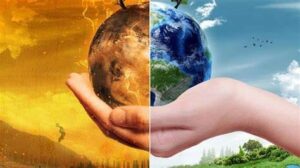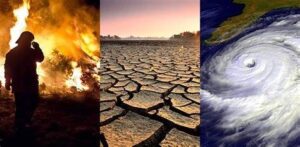“Global warming” refers to the rise in average temperature of the Earth’s climate system which is mainly caused by humans. It is the long-term heating of Earth’s surface observed since the pre-industrial period (between 1850 and 1900) due to human activities. Primarily, the major cause of global warming is the combustion of fossil fuels like coal, oil, and gas which produces heat-trapping gases. The increase in levels of heat-trapping greenhouse gases such as water vapor, carbon dioxide, methane, nitrous oxide, and ozone in the Earth’s atmosphere leads to “Climate Change” phenomenon. The following points explain the causes and effects of Global warming and Climate change on our environment:

(picture courtesy:global warming – Bing images)
Causes: The greenhouse gas emissions blanket the Earth and trap the atmospheric heat that is received from the Sun. Today, our world is warming faster than at any point in the recorded history, leading to rapid global warming and climate change. The major contributing causes are:
• Power generation: Generating electricity and heat by burning fossil fuels such as coal, oil, and natural gas causes release of vast amounts of global emissions. Even now, most of the electricity is still being produced from fossil fuels. Production of electricity from renewable resources such as hydro, solar, wind, and tidal only accounts for 25% of global power generation.
• Manufacture of goods: Industrial manufacture of various commercial products produce emissions. Combustion of fossil fuels to produce energy for production of cement, iron, steel, electronics, plastics, clothes, and other goods, in addition to mining and other industrial processes release greenhouse gases.
• Deforestation: Cutting down forests to create timber, farms, pastures, or residential and industrial areas leads to emissions. When trees are cut, stored carbon and organic matter get released into the surrounding atmosphere and soil. As forests absorb carbon dioxide and release oxygen, destroying them limits nature’s ability to keep emissions out of the atmosphere.
• Modes of transportation: Most of the cars, trucks, ships, and planes run on fossil fuels. Therefore, transportation is a major contributor of greenhouse gases, especially carbon-dioxide emissions.
• Agriculture and production of food: Producing food requires energy tapped from fossil fuels to run farm equipment and fishing boats. Additionally, growing crops using fertilisers and manure cause emissions. Cattle produce methane which is a major greenhouse gas. Packaging and distributing food using plastic material emit greenhouse gases.
• Power to industrial and corporate buildings: Globally, industrial, residential, and commercial buildings consume most of the electricity. Buildings continue to draw on energy produced from coal, oil, and natural gas for functioning of equipment, heating, and cooling purposes.
• Concrete jungles: Closely packed huge, solid concrete buildings in cities without natural greenery emit significant quantities of greenhouse gas emissions.
• Excessive consumption and wastage of resources: Increase in consumption and wastage of goods such as processed food, luxurious synthetic goods, clothing, electronics, and plastics contribute to greenhouse gas emissions.

(picture courtesy:effects of global warming – Bing images)
Effects: Over time, during the past centuries when human intervention has increased, unusual and gradual rise in temperatures have been observed. These temperature variations lead to change in weather patterns and disrupt the usual balance of nature. This poses many risks to human beings and all other forms of life on Earth. The hazardous devastating effects are:
• Hot temperatures: Recently, most of the terrestrial habitats are experiencing highly hot climate and heat waves (2020 was one of the hottest years on record). High temperatures increase heat-related illnesses and cause more difficulty to work and move around. Wildfires start more easily and spread more rapidly during hot climate.
• Severe storms: Changes in temperature cause changes in rainfall that results in severe and frequent storms. They cause floods and landslides that destroy habitats, communities, and economies of nations.
• Frequent droughts: Disturbed water cycle is causing water scarcity in many regions. Deserts are expanding and agricultural fertile land for growing crops is reducing at global scale.
• Rise in warmth and surface level of oceans: The ocean soaks up most of the heat from global warming. This melts ice sheets (glaciers) and raises sea levels, threatening coastal and island communities. Additionally, the ocean absorbs carbon dioxide, keeping it from the atmosphere. High carbon dioxide makes the ocean more acidic, which endangers marine life forms.
• Loss of species: Climate change poses risks to the survival of species on land and in the ocean. Forest fires, extreme weather, and invasive pests and diseases are among many threats. Some species will be able to relocate and survive, but others will become endangered.
• Deficit of food: Changes in climate and increase in extreme weather events are among the reasons behind a global rise in hunger and poor nutrition. Fisheries, crops, and livestock are destroyed or become less productive. Heat stress can diminish water and grasslands for grazing and agriculture.
• Health hazards and risks: Changing weather patterns are spreading diseases such as malaria, cholera, and viral and bacterial infections. Other risks to health include increased irregular functioning of organ systems in human body.
• Poverty and displacement: Climate change increases the factors that cause and restrict the people to remain under the poverty line. Floods, cold and heat waves affect urban slums and destroy livelihood of people. Weather-related disasters displace 2.3 crore people a year, leaving many more vulnerable to poverty.
